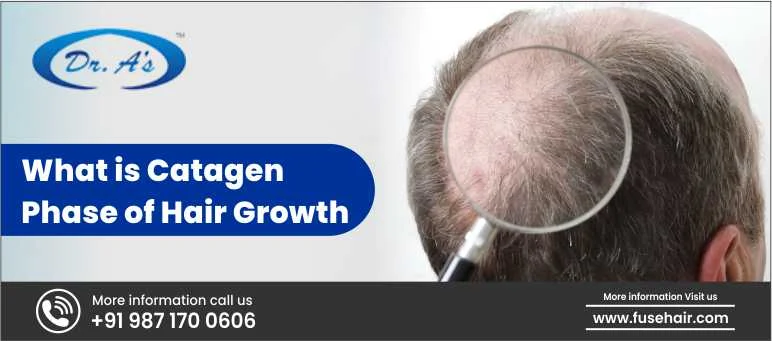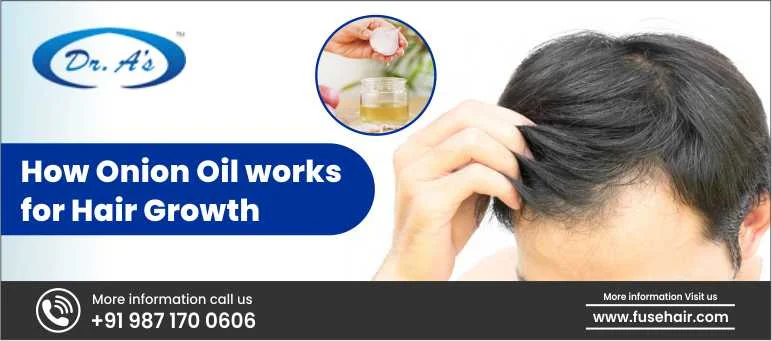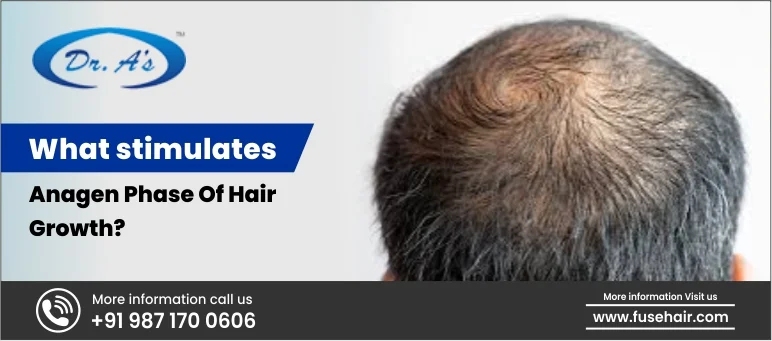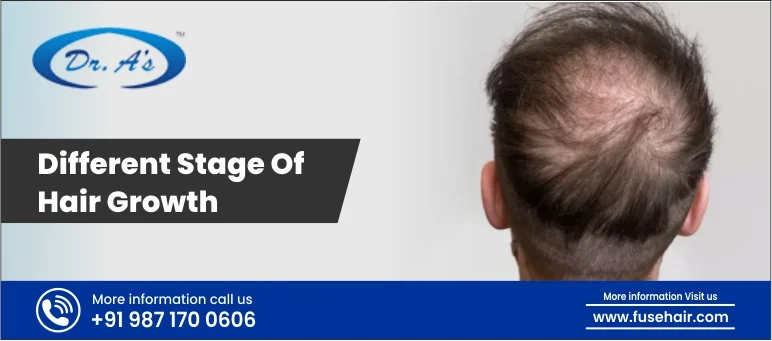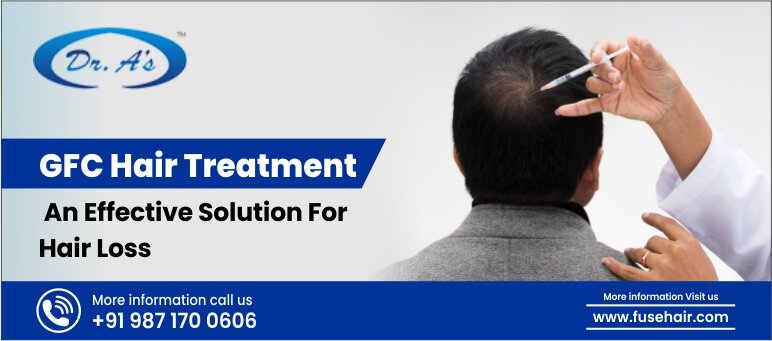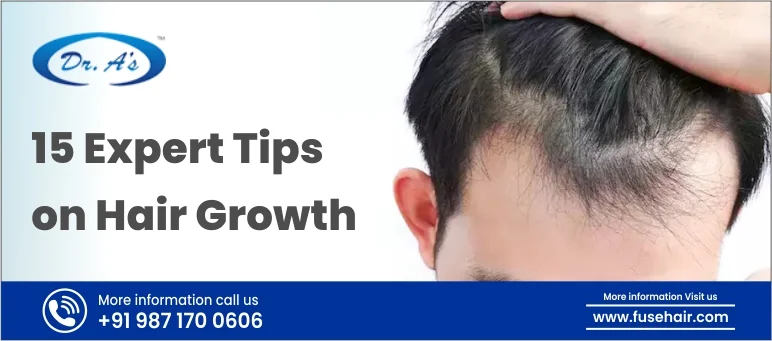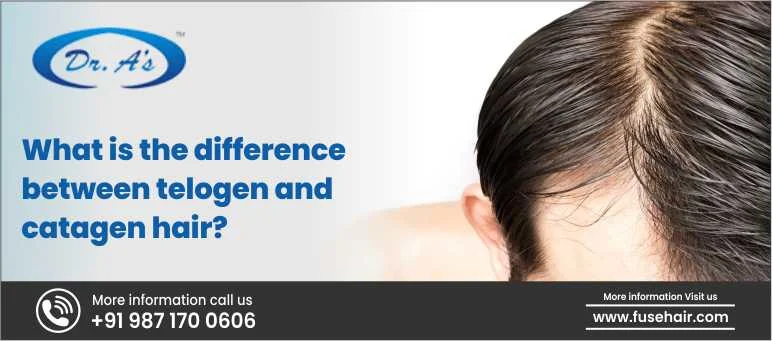
Our natural hair growth cycle consists of three stages: growth, rest, and shedding to maintain the continuous renewal process. These three distinct phases of the hair cycle are known as Anagen, Catagen, and Telogen. Each of them performs different functions that help generate healthy hair on your scalp while promoting the overall well-being of your hair.
Anagen is the initial point from which the hair growth starts, catagen represents the transition stage, and telogen represents the resting stage that takes place before hair shedding occurs. Knowledge about these stages allows you to handle hair thinning more effectively while stopping unnecessary hair shedding.
We at Dr. A’s Clinic offer expert hair restoration solutions to foster the development of follicles throughout the hair growth cycle so that you can get healthy, fuller hair with a healthy scalp.
Understanding the Hair Growth Cycle
Each hair strand cycles through four stages continuously to maintain growth, rest, and regeneration. These stages are:
- Anagen (Growth Phase): Hair grows actively for a period of 2-7 years.
- Catagen (Transition Phase): A brief 10-14 day interval where hair growth ceases.
- Telogen (Resting Phase): It lasts for 2-3 months, where hair prepares for shedding.
- Exogen (Shedding Phase): Old hair sheds to allow new hair growth.
It has been seen that both catagen and telogen are vital phases when it comes to the regular cycle of hair. Now, let’s explore these two phases in greater depth to uncover how they can affect your hair health.
What is the Catagen Phase?
The transition period of the hair growth cycle, known as catagen, exists for a duration of 10-14 days. During this phase, hair follicles enter a state of shrinking while detaching from the blood supply to prevent additional growth. When catagen finishes, it enables hair follicles to transition to the upcoming phase. Your hair stays stationary throughout the catagen period while the shaft continues to grow slowly till it reaches the next phase, i.e., the Telophase.
Stages of Catagen
The following stages of catagen help in transitioning the process to the next phase:
- Hair follicles shrink and separate from the dermal papilla.
- Hair ceases to grow but remains embedded in the follicle.
- The follicle then creates a club hair, which will eventually shed in the telogen (when the hair rests) or exogen (the shedding phase) phase.
Importance of the Catagen Phase
The catagen phase, which exists only for a short period, guides the fundamental process of renewing healthy hair. This process stops hairs from persistently growing while new growth takes over old hair strands. However, disruptions in the catagen phase may also be observed, like premature entry to the stage due to stress, illness, or hormonal imbalance, leading to hair thinning over time.
At Dr. A’s Clinic, we assist you in diagnosing and fixing irregularities in your hair cycles. Through our expert hair restoration treatments, including PRP therapy, LLLT therapy, and follicular regeneration, Dr. Arvind Poswal assists clients in maintaining healthy hair development while stopping unwanted hair loss.
What is the Telogen Phase?
The second-last stage, telogen, is where hair growth rests and takes almost 2-3 months to finish. At this phase, hair remains rooted inside the follicle but stops all growth-related activities. This hair gets ready for shedding after a new hair structure starts forming. It eventually helps in the growth of new hair and moves to the next stage of your hair cycle to complete the process.
Stages of Telogen
The following stages of telogen help complete the hair cycle properly:
- Hair follicles could be dormant, but they still contain the hair that already existed.
- Hair goes into a persistent fall state and is estimated to affect about 10-15% of hair on your scalp at any given time.
- Hair starts to slowly detach from the follicle and gets ready to fall off.
- At the end of this phase, the exogen phase starts, and the old hair falls off.
Reasons Behind Telogen-Related Hair Loss
Although shedding is normal, excessive hair loss can happen if too many follicles enter the telogen phase at once, a phenomenon referred to as telogen effluvium. This can be triggered by:
- Stress or illness
- Nutritional deficiencies
- Hormonal changes (e.g., postpartum hair loss)
- Sudden weight loss or medical treatments
In the course of time, this has become a common problem. The personalised care we offer at Dr. A’s Clinic allows you to restore the lost balance in your hair cycle. The combination of PRP therapy and medical hair regrowth plans from our clinic will help you not only regrow healthy, natural hair but also stop undesired excessive hair loss.
Key Differences Between Catagen and Telogen
Through a clear cyclical pattern, the human scalp facilitates both catagen and telogen as separate yet linked phases, which guide hair development. Each of these stages has its distinct functions, which regulate hair growth to complete the cycle of hair formation. Below, we’ve discussed the key differences between catagen and telogen phases for you to understand your hair growth process better:
Duration and Timing
The catagen phase lasts for a short transitional interval, extending from 10 to 14 days, that starts post-anagen (growth) phase. In this phase, your hair goes through the transition from the active phase of growing to the resting period. On the contrary, telogen has a longer duration of 2 to 3 months and is a resting phase as hair follicles go through shedding.
The important difference between these two phases of the hair growth cycle is that telogen affects the entire scalp hair most of the time, while catagen only affects a reduced share of hair.
Function in the Hair Growth Cycle
The catagen phase serves as a transitional period that causes hair follicles to minimize their size while detachment occurs from blood circulation, thus ending active growth. Thus, it controls unlimited hair development while maintaining equilibrium throughout the renewal process.
During telogen, follicles keep the club hair from growing until another hair cycle starts. The total absence of growth is present in telogen, but this phase contains hair that will shed sooner than strands in catagen would.
Impact on Hair Loss
Hair shedding occurs during both catagen and telogen phases, yet they affect hair loss through separate mechanisms. Catagen phase disturbances trigger the hair to advance improperly to the resting phase, which reduces hair strength and eventually leads to a decrease in hair volume.
Quick movement of hair into telogen reduces the number of growing hairs as the hair falls off. This shedding pattern during the telogen phase leads to a stage called telogen effluvium, which is a premature hair loss pattern. It implies that an excessive number of hairs entered the resting phase, leading to evident hair loss.
Managing Hair Cycle Imbalances
Whether you are searching for catagen imbalance remedy or telogen recovery solutions, it is vital to determine from which phase the hair loss stemmed. Dr. Arvind Poswal suggests LLLT, PRP therapy, and minodixil to manage catagen durations effectively. Meanwhile, he recommends clients with an extended or reduced telogen phase to regulate their hormones to optimum levels, manage stress properly, and take finasteride for proper resolution of the issue. At Dr. A’s Clinic, we aim to deliver advanced hair solutions that help you maintain the regular hair cycle for perceivable hair advancement and get healthy regrowth effectively, no matter whether you’re dealing with issues in the catagen or telogen stage.
Impact of Catagen and Telogen on Hair Growth and Regrowth
The two phases, catagen and telogen, work together to prevent instability within the regular hair growth pattern. A balanced regime between growth and shedding of hair occurs when all phases operate at their normal levels. Hair loss, together with thinning, results as a consequence of disturbances in either phase of the hair cycle.
Here are some major consequences of disruptions in catagen and telogen phases that can affect your hair quality and lead to problems related to your hair:
- Premature catagen phase shortens the hair growth cycle, resulting in poorer hair density over time.
- A prolonged telogen phase results in an uptick in shedding, which can result in conditions such as telogen effluvium.
- Stress, poor diet, and hormonal imbalances can throw these phases out of balance.
At Dr. A’s Clinic, we deliver advanced hair restoration treatments that restore both natural balance to your hair cycle and help regenerate your hair.
Conclusion
Natural hair cycle depends on catagen and telogen phases for continued healthy hair growth. But disruptions in these stages result in either thinning or uncontrolled shedding of hair. We, at Dr. A’s Clinic, specialize in offering advanced therapeutic approaches that produce the best results for hair regrowth and extended hair wellness. Based on your current hair condition, we customize your treatment plan to help you get the hair you deserve!


